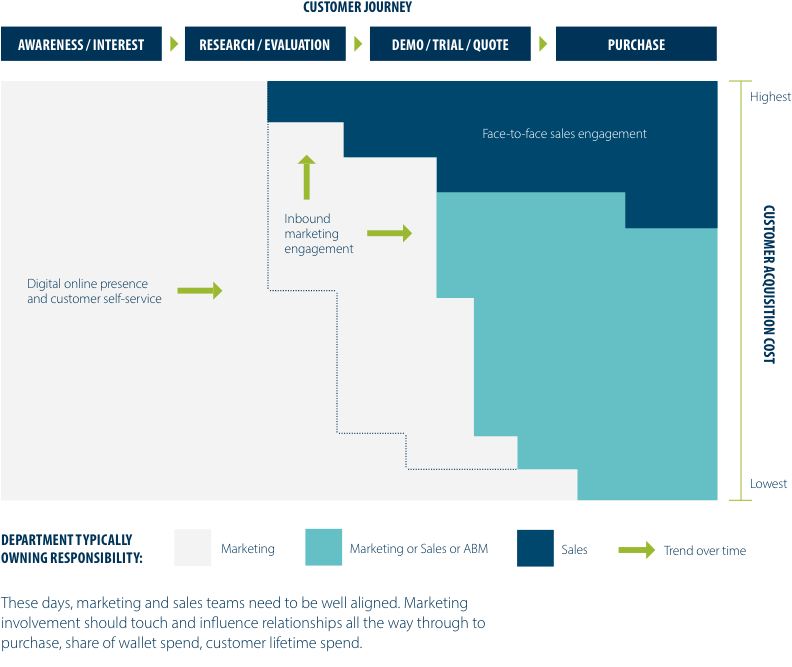With the end to lock down restrictions on 19 July 2021, B2B organisations just want life to return to normal. In reality though, life won’t return to the pre-COVID norm because fundamental preferences have shifted.
Following Covid 58% of sales reps believe their role has fundamentally altered.
The shift to remote, digital interaction between buyers and sellers has exposed major challenges to old commercial ways and unearthed new opportunities.
Not least, how marketing automation can attract, develop and qualify leads long before they ever speak to sales rep.
It's showed how we can employ technology and best practice to drive B2B sales outcomes and the customer lifecycles.
Digital transformation
But long before the pandemic, top performing organisations were levering digital channels to drive early and middle stage conversations with prospects and customers in a ‘self-service’ phase.
Digital interactions were at the forefront of every customer interaction. They were enabling the customer to research, get comfy, find reassurance, build trust in their minds – long before they even spoke to a sales person. This had the effect of reducing the time between ‘first touch’ and deal close and it reduces the cost of acquisition.

But, why end digital support at the journey between first sale ‘opportunity’ and first ‘win’?
The same principles should apply right across the customer experience from marketing, to sales, to customer service and in between. We should be thinking closed loop – not in a linear line.
This doesn't mean sales and field sales people are useless or outdated. Far from it.
But the rules of effective engagement and sales support have changed. Organisations need to consider their CRM and customer case, develop interactive pathways and improve customer lifecycle value seamlessly, with digital outreach.
This is called sales enablement.
Key imperatives of sales enablement
Creating an effective customer experience requires a concerted effort by multiple stakeholders – research, marketing, sales and customer service teams. It requires redesigning processes, implementing appropriate technology stacks and changing the culture within marketing, sales and service teams.
No longer can the organisation think that particular teams own particular customers.
It is better to recognise that all teams can add value and speak to customers in powerful and dynamic ways throughout the customer life cycle.
- Plan and build omnichannel experiences
- Sales people become temporary stakeholders (one of many) with shorter, more intelligent interactions
- Improve and expand inside-sales touch points (research, marketing, customer service outreach)
- Focus on the longer-term, whole of life customer value (not just the near-term sale)
- Integrate marketing, sales and customer service operations
Plan and build omnichannel experiences
Historically, sales have been an isolated business function too often predicated around ‘new’ or ‘new-new’. Companies have had ‘sales’ ‘internal sales’, e-commerce, indirect sales and distribution/partner channels competing for bragging rights or transaction headlines.
It is not a particularly joined up brand or attractive experience for customers.
It’s far better to employ digital roadmaps that use ‘Learn’ and ‘Knowledgebase’ to take companies and contacts on a digital journey that endears them to you, answers questions, builds subject matter authority and provides plenty of opportunities to convert and engage – at the top, middle and bottom of the buying journey.
In SaaS companies for example, they use omnichannel experiences to extend relationships and increase the deal value of potential purchases, or even tee-up repeat or upgrade orders, long before the buyer actually speaks to someone.
Delivering omnichannel experiences requires companies to think about ideal customer profiles, personas and create content that address customers problems, removing friction and increasing customers’ lifetime value.
Each internal department has a role to play and needs to be seamlessly linked through both CMS and the CRM.
Executing an effective omnichannel experience requires organisations to rethink their internal processes and collaborate through customer-centric goals and metrics while avoiding departmental solios.
Shorter, more intelligent sales team interactions
There are many types of sales people. The ‘lone warriors’. The ‘relationship managers’. The ‘challenger sales’ types. The latter can be far more dynamic and profitable in nearly every circumstance. Asking “why” and teasing out the negative consequences of not acting and the positive implications of acting. As well as focussing on higher value, objection-satisfied sales.
To succeed, sales reps require analytic-enabled CRM systems that can deliver sales insights, identify trigger events, use lead scoring and other analytics to help prioritise time and suggest next action on a sales cycle and identify opportunities across a pipeline to support up-sell and cross-sell. These techniques will determine if a physical meeting or call is required and can drive more structured calendars, timelines, customer objection handling and speed up the time between first ‘touch’ and order won.
Give internal sales desks a larger, wider remit
Two important steps to achieving this are;
(i) Give internal sales/support desks more and higher value accounts (they have the time and focus to deal with more complicated, nuanced needs)
(ii) Train all customer-facing reps to manage more of the customer journey. This requires organisations to abandon short-term transactional thinking in favour of a whole of life digital journey approach and reduces dependency on ‘farmers’
Focusing on long-term customer lifecycle (not just the initial sale)
We all know it costs considerably less to intelligently service an existing customer than to identify, nurture and convert a new customer who may or may not repeat order.
This makes getting closer to and getting more from existing customers, even more significant. Companies need to focus on managing long-term relationships which will require changes in internal roles and responsibilities. Focus on creating a robust customer success function, use NPS (Net Promoter Score) and hold all client-facing reps accountable for customer satisfaction.
To succeed at scale, the whole organisation needs to be proactive, inter-linked, use data to focus on unmet customer needs, identify opportunities for up-selling and cross-selling and reduce customer churn. By getting customer success right, companies can increase the average annual lifetime value of loyal customers by up to 20% (HubSpot).
Integrate sales, marketing and customer service operations
Leading high-growth organisations use an operational approach that creates and manages company-wide revenue and promotional strategies. These are traditionally led by a strategic marketing director working in close partnership with a Chief Operating Officer solely focused on operations. Together, they form a ‘pincer movement’ which informs and drives customer success, repeat orders, customer lifetime value, the helpdesk and all sales functions. It’s called marketing-led growth. It delivers sales enablement.
To get started, read the ebook ‘Sales enablement – how sales, marketing and customer service teams can reliably win and close more business’. Sales enablement is a strategic business decision. Consider key metrics for measuring customer success across the whole customer journey. Rethink ownership and segmentation of account responsibility internally. Close critical omnichannel gaps. Invest in training and focus on team morale. Listen, think and act agile and provide stronger leadership. The right people, in the right seats, will follow and pick up the baton.


